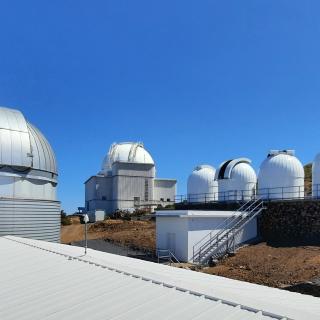It may interest you
-
 The Instituto de Astrofísica de Canarias (IAC) and the Canary, La Palma Reserve of the Biosphere Foundation have signed a document agreeing on actions to be taken in prevention, early warning and rapid response to exotic invading species on the Island of La Palma, a World Biosphere Reserve.Advertised on
The Instituto de Astrofísica de Canarias (IAC) and the Canary, La Palma Reserve of the Biosphere Foundation have signed a document agreeing on actions to be taken in prevention, early warning and rapid response to exotic invading species on the Island of La Palma, a World Biosphere Reserve.Advertised on -
 The Instituto de Astrofísica de Canarias (IAC) and the KU Leuven , Belgium, have amplified their framework of collaboration in astrophysical research. The two institutions have signed an agreement which gives continuity to the operations of the Mercator Telescope at the Roque de los Muchachos Observatory (ORM), which started in 2002, and whose work will be strengthened by the installation of a new instrument called MARVEL (Mercator Array for Radial Velocities). Mercator is a semi-robotic telescope with a 1.2 metre primary mirror. Its name comes from that of the famous Flemish cartographerAdvertised on
The Instituto de Astrofísica de Canarias (IAC) and the KU Leuven , Belgium, have amplified their framework of collaboration in astrophysical research. The two institutions have signed an agreement which gives continuity to the operations of the Mercator Telescope at the Roque de los Muchachos Observatory (ORM), which started in 2002, and whose work will be strengthened by the installation of a new instrument called MARVEL (Mercator Array for Radial Velocities). Mercator is a semi-robotic telescope with a 1.2 metre primary mirror. Its name comes from that of the famous Flemish cartographerAdvertised on -
 This is the third “mini-Moon” with lunar-like material identified as part of the Arjuna asteroid belt, where objects follow similar orbits around the Sun to that of the Earth-Moon system. IAC, February 6, 2025. – Near-Earth asteroid 2024 PT5 orbits around the Sun following a trajectory very similar to that of the Earth-Moon system, and during two months of 2024, it accompained our Earth on its journey. This asteroid has material on its surface that was originated in the Moon, as it has been proved by a research led by the Insituto de Astrofísica de Canarias (IAC) and the UniversidadAdvertised on
This is the third “mini-Moon” with lunar-like material identified as part of the Arjuna asteroid belt, where objects follow similar orbits around the Sun to that of the Earth-Moon system. IAC, February 6, 2025. – Near-Earth asteroid 2024 PT5 orbits around the Sun following a trajectory very similar to that of the Earth-Moon system, and during two months of 2024, it accompained our Earth on its journey. This asteroid has material on its surface that was originated in the Moon, as it has been proved by a research led by the Insituto de Astrofísica de Canarias (IAC) and the UniversidadAdvertised on
